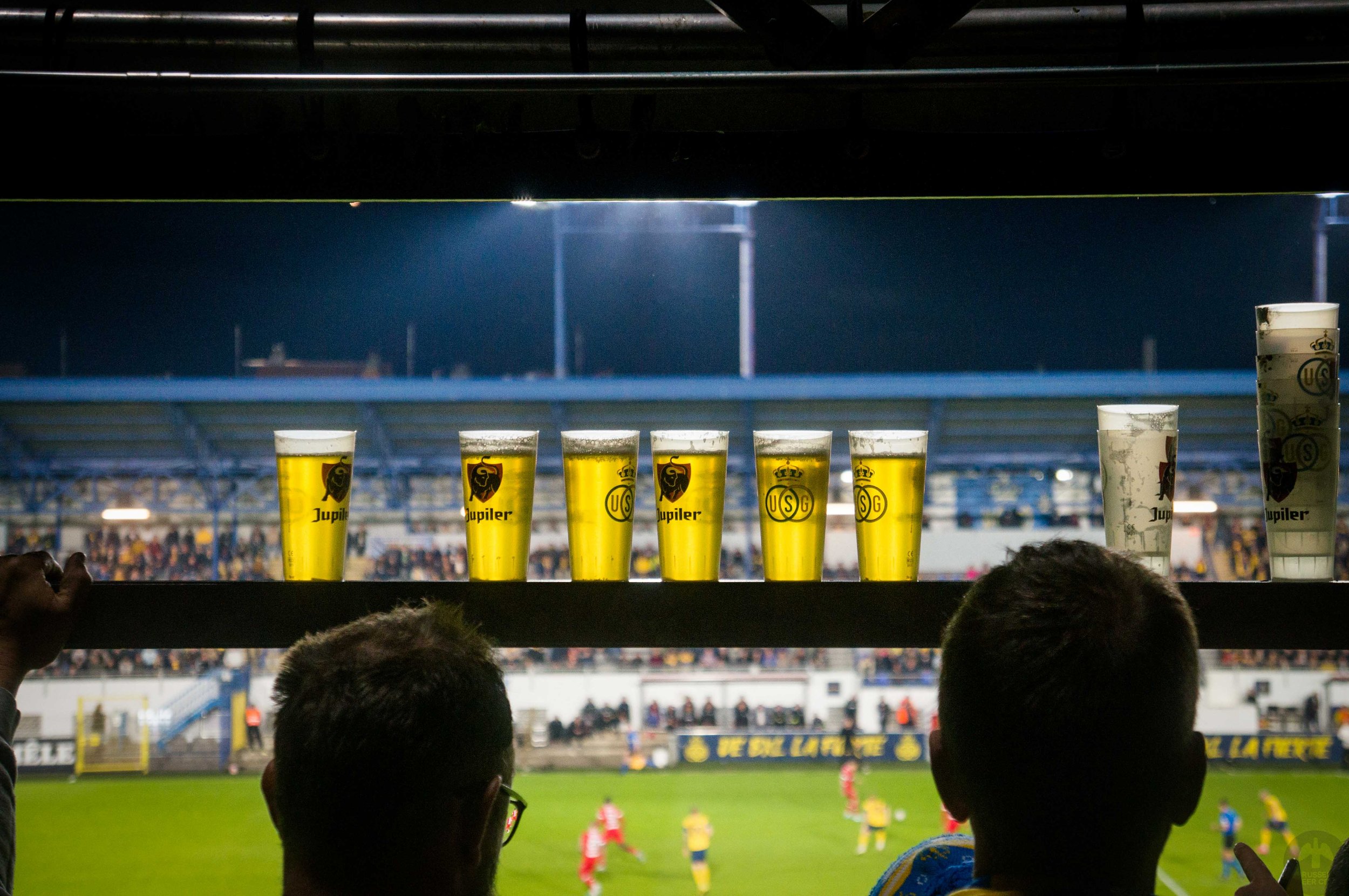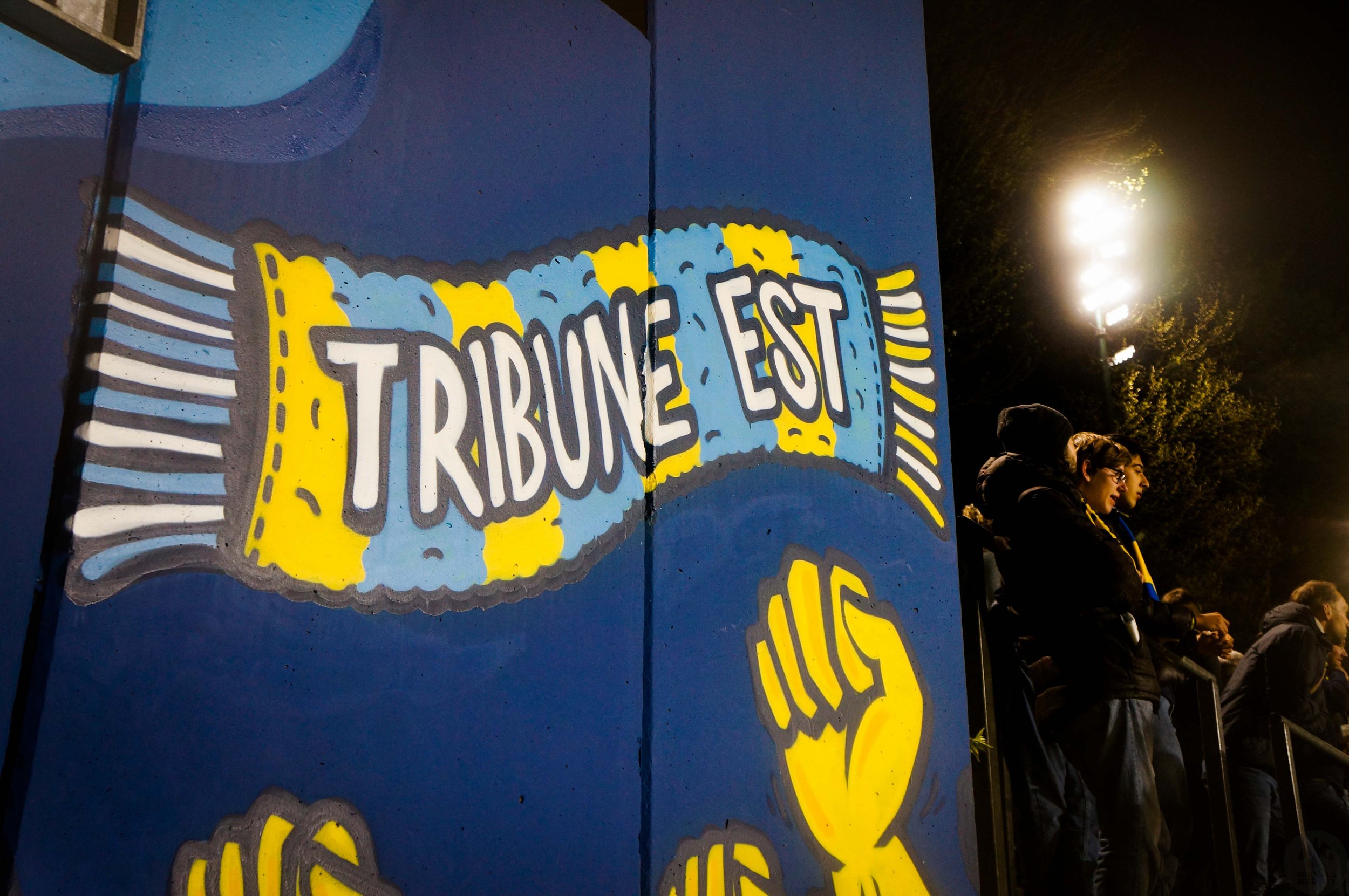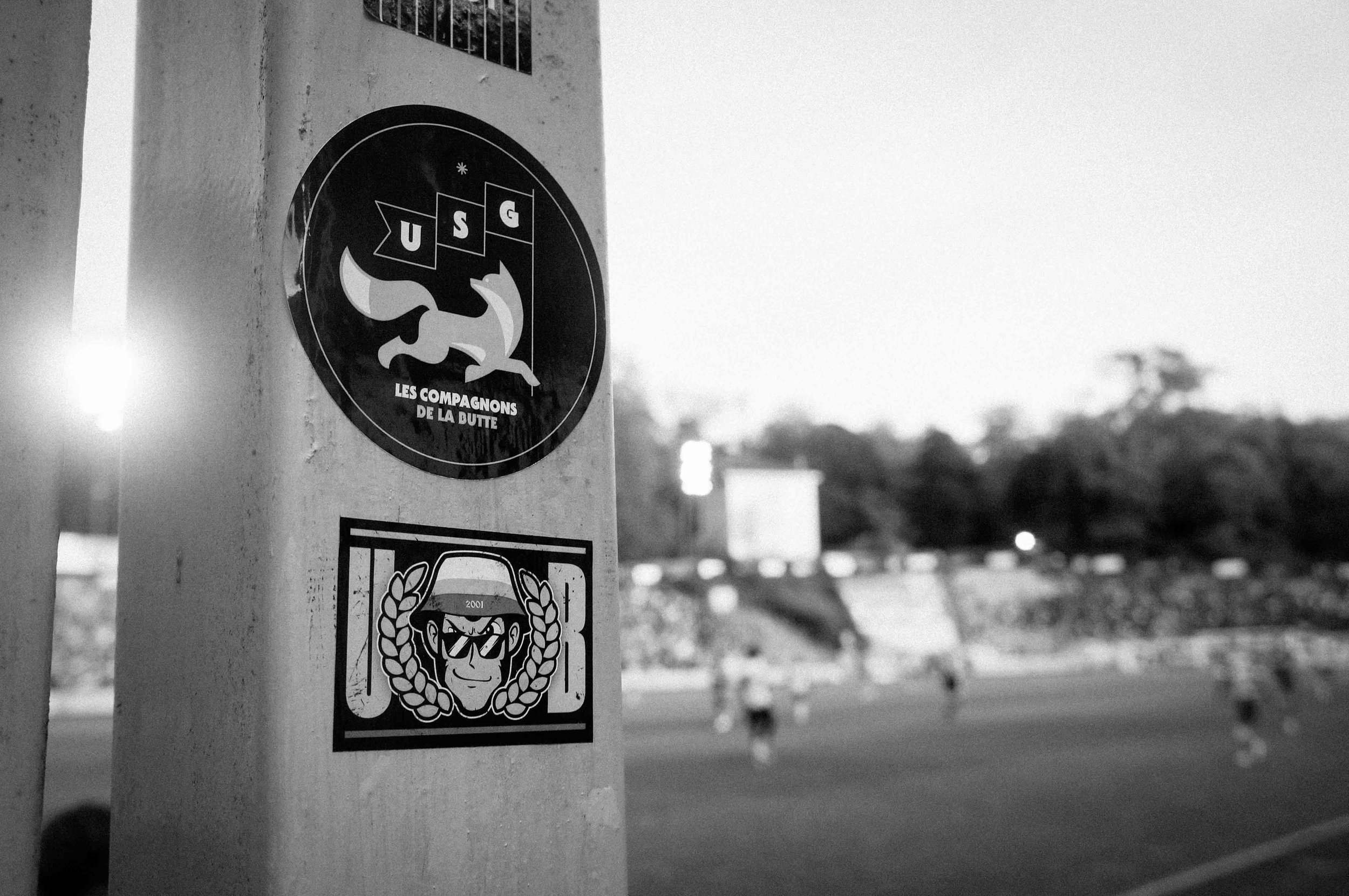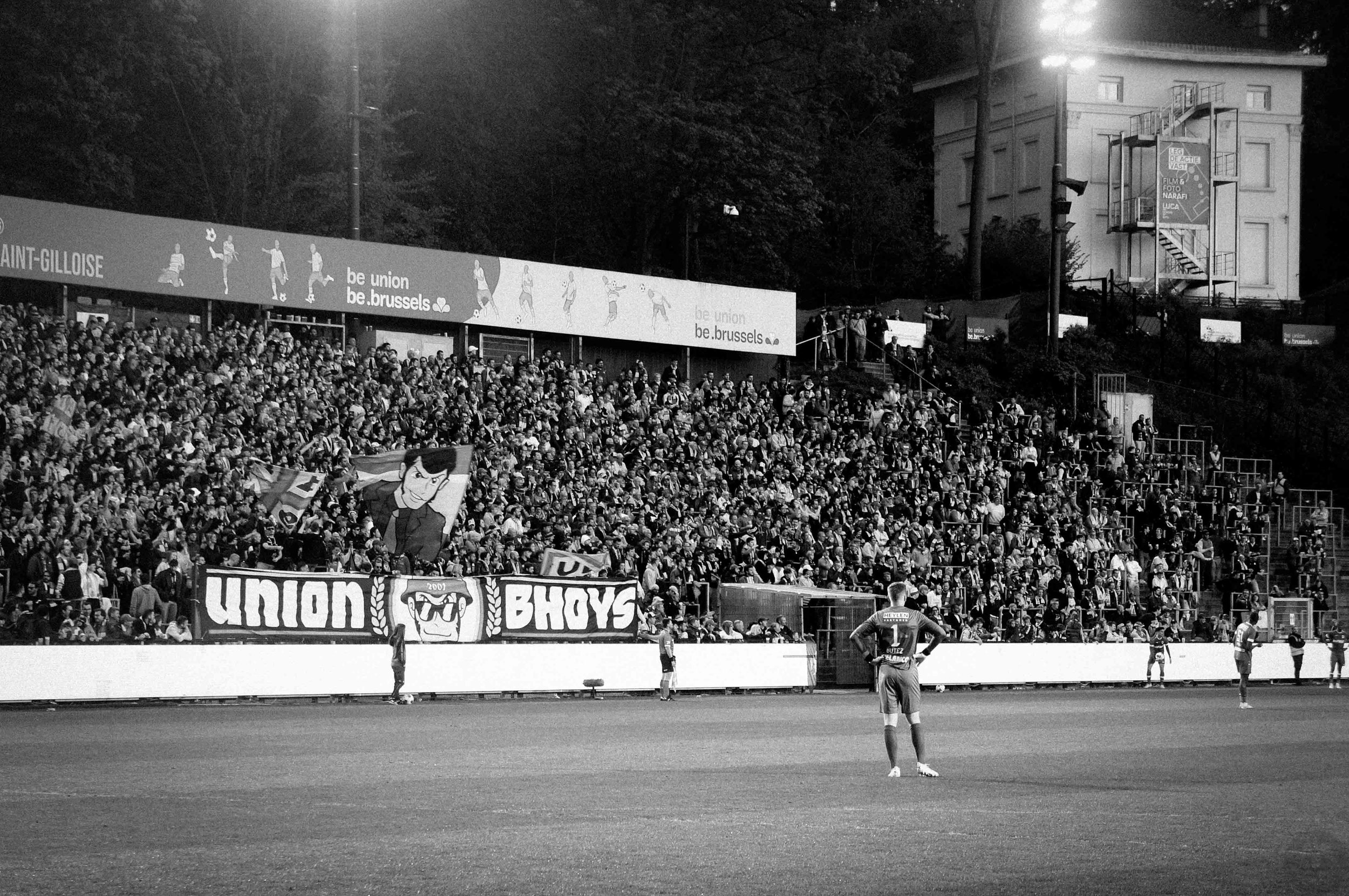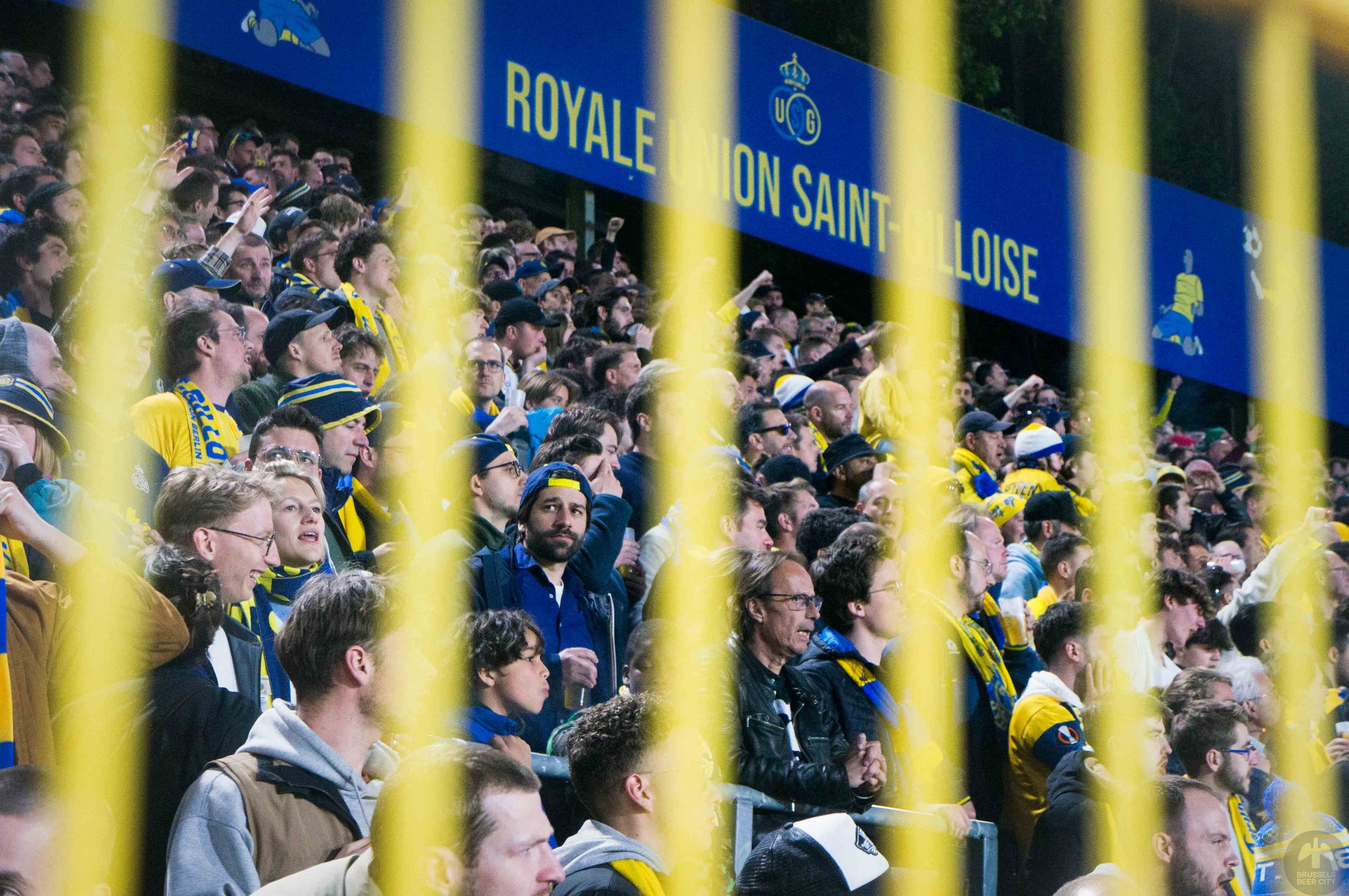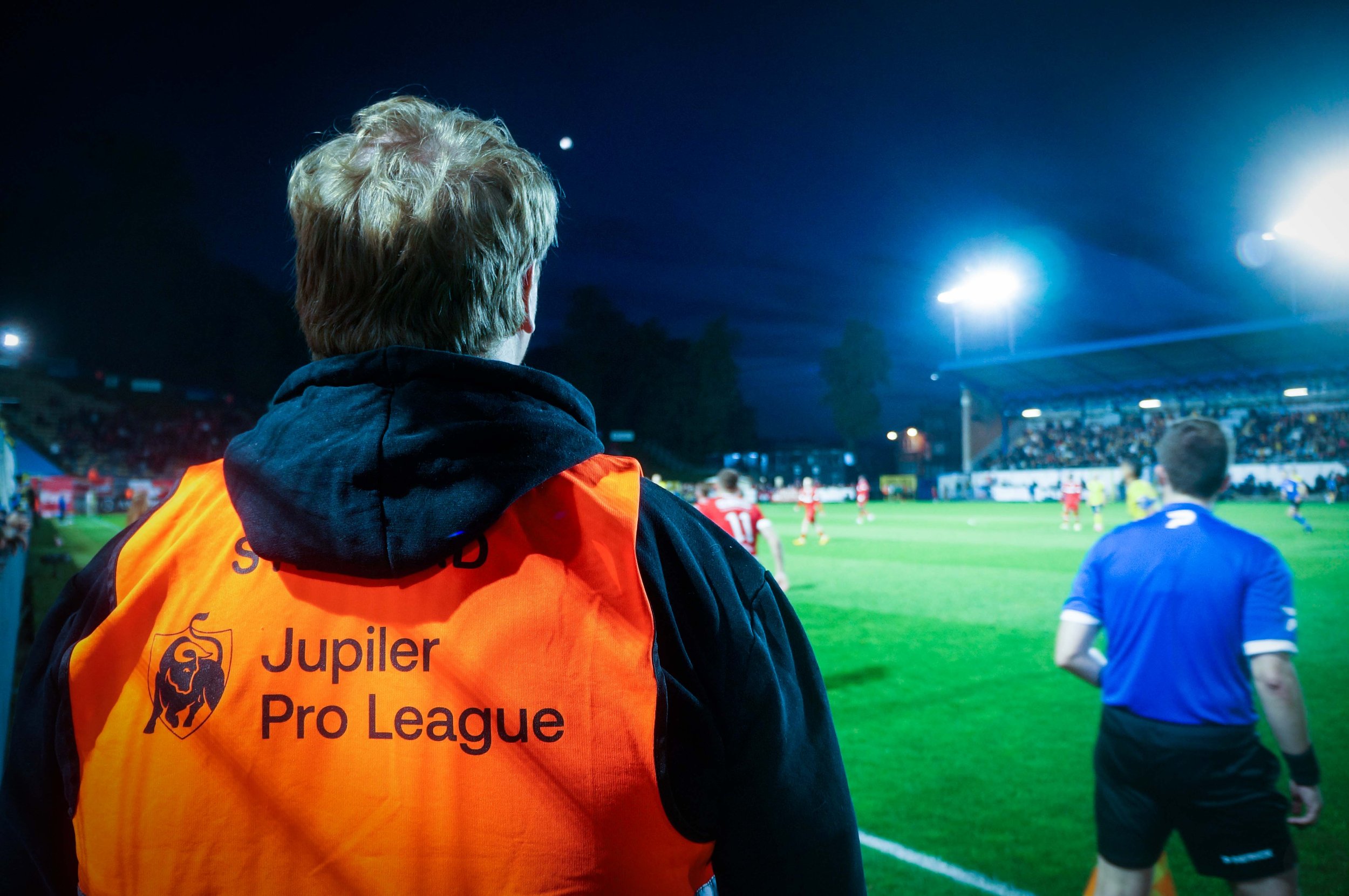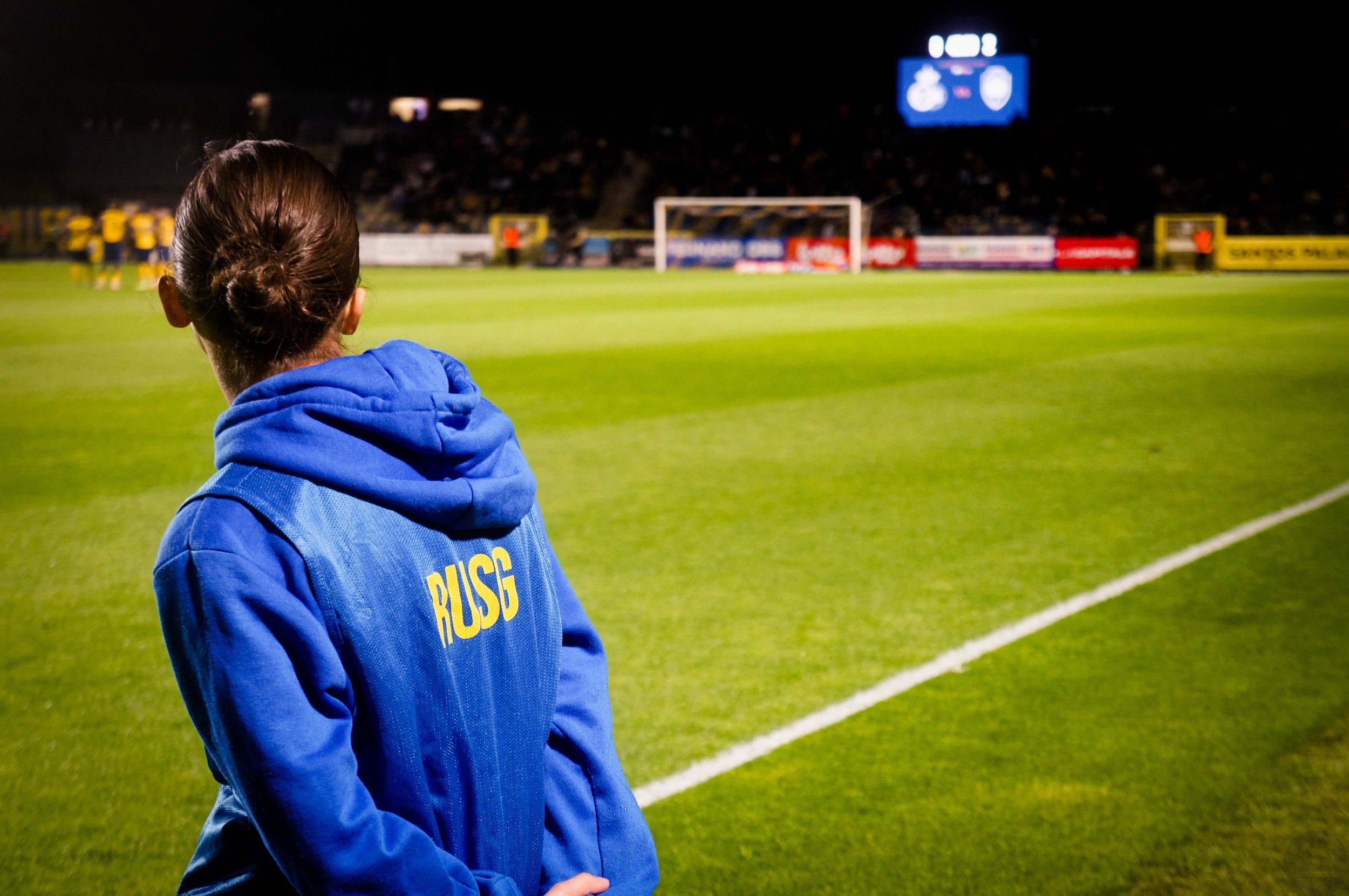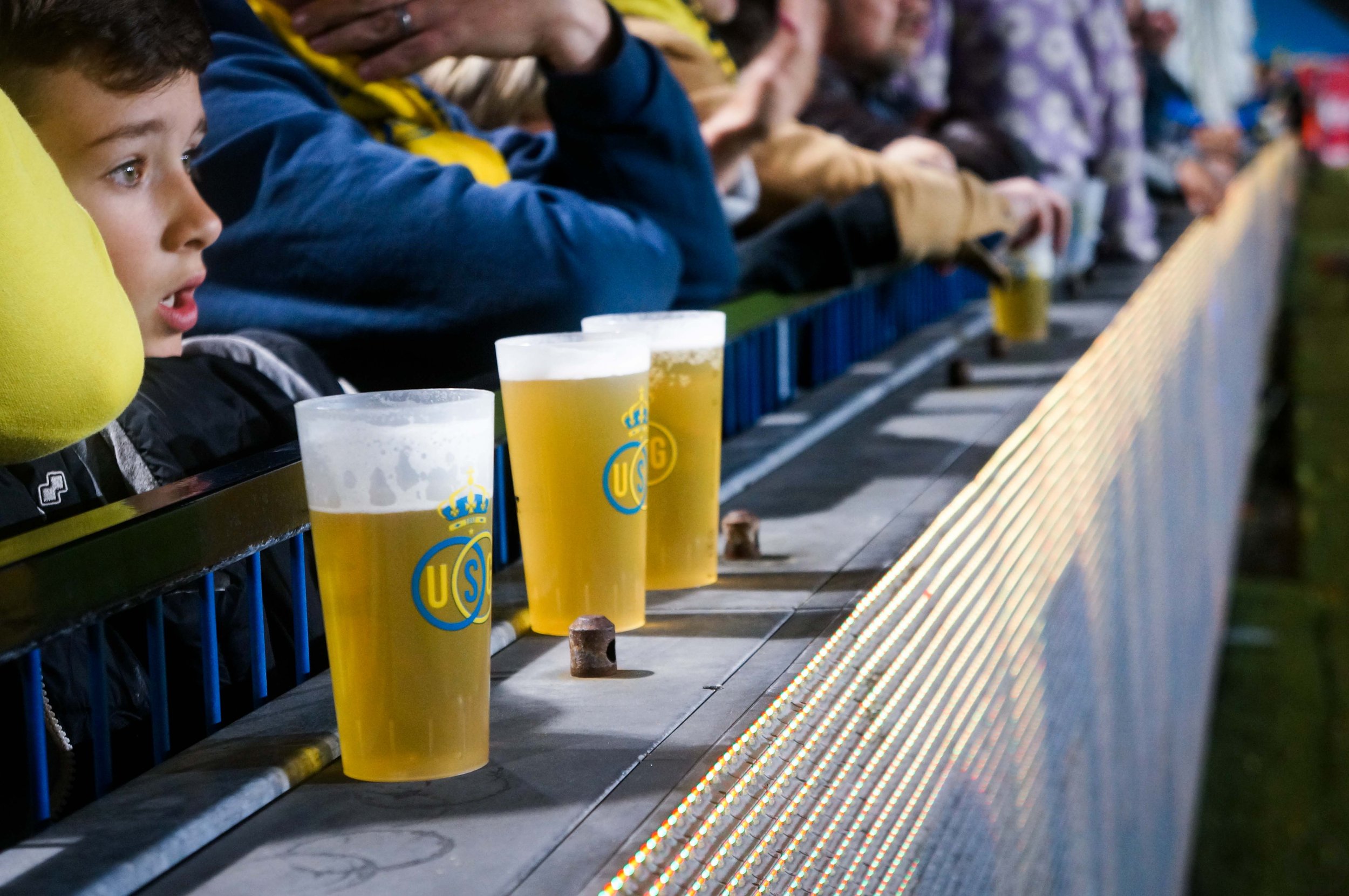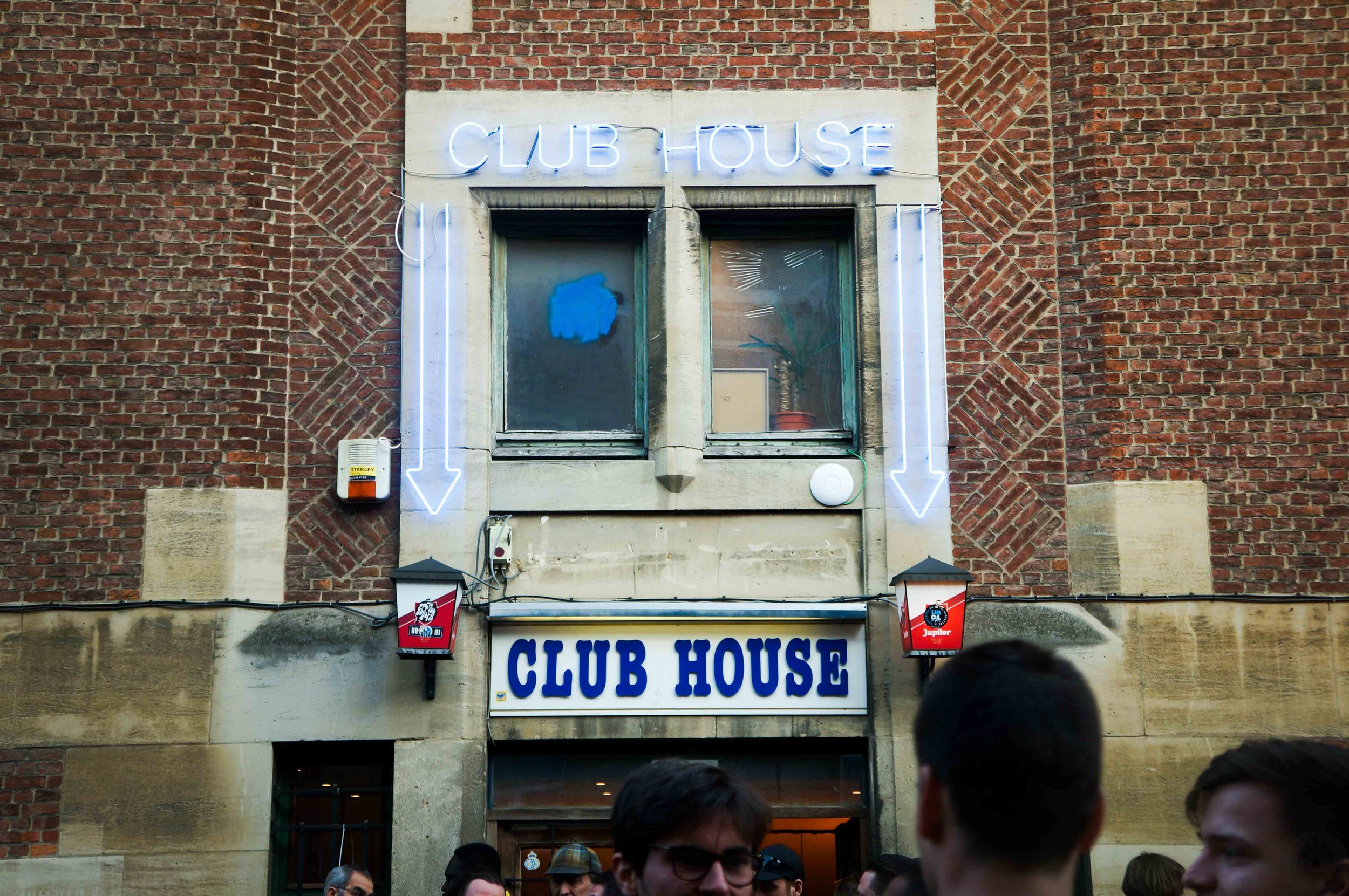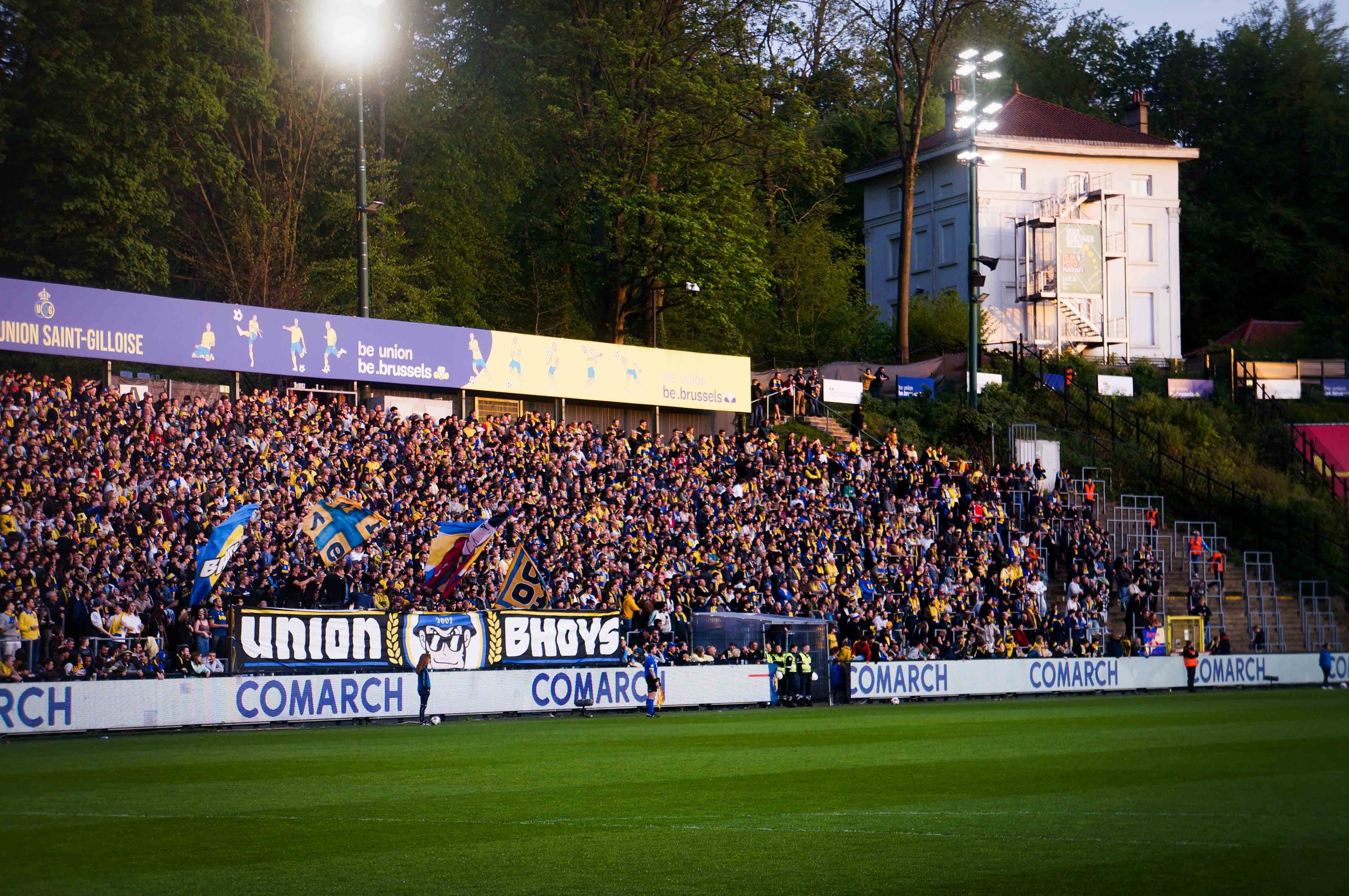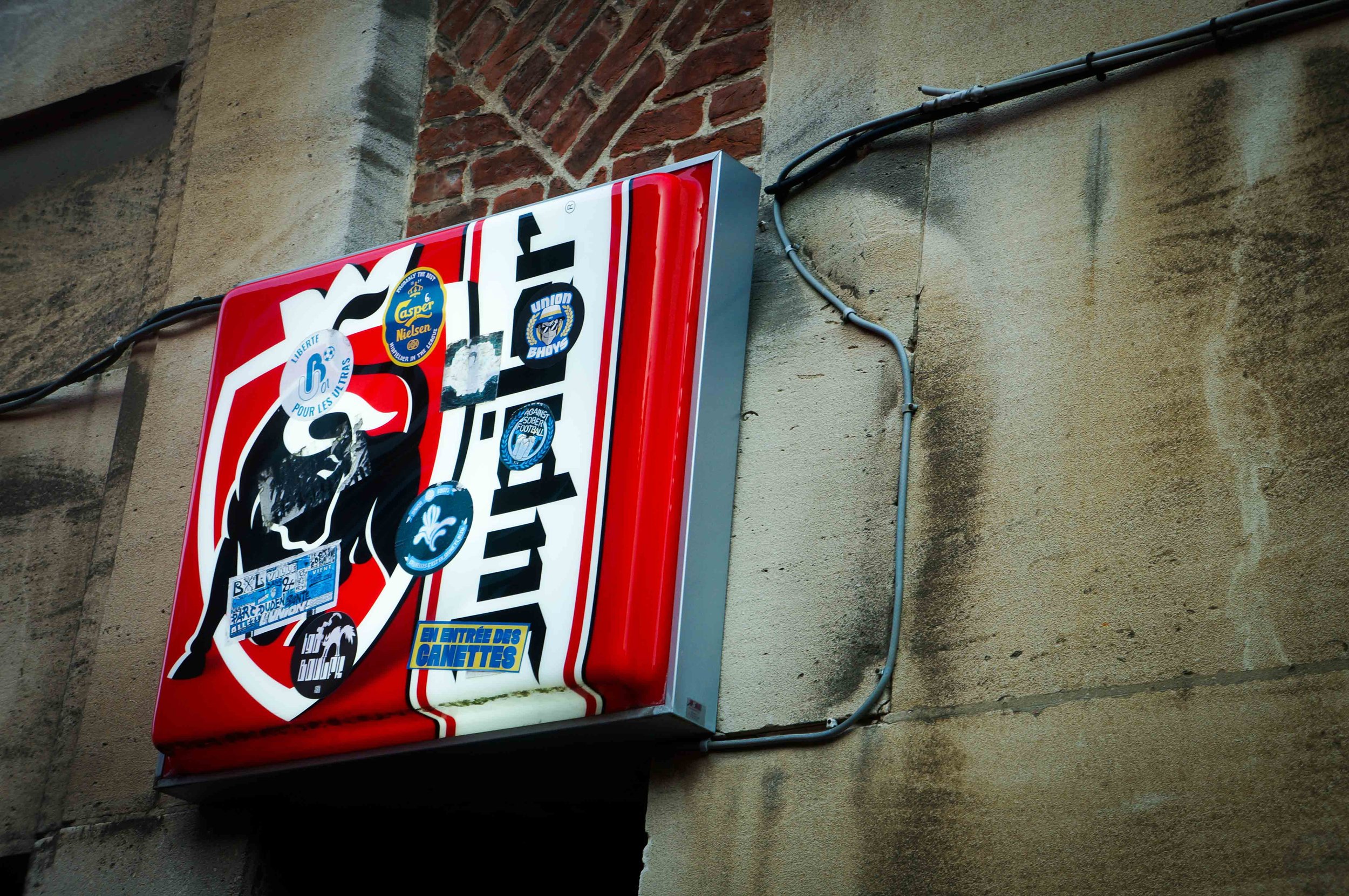Next Gueuze Wins // Royale Union Saint-Gilloise, Brussels' undisputed brewers football club
22/10/2022, 20.45: Union versus Club Brugge tonight, fourth against third. The Clubhouse bar smells of microwaved fish pie, and the queue for drinks is three-deep. €10 a bottle. There’s Sam from En Stoemelings, putting his Union jacket on—his war fatigues. Looking across from the entrance to the toilet under the main stand to the Kop opposite, the Union Bhoys are already in full voice. The stadium sound system plays the Black Eyed Peas. Tonight's gonna be a good night.
***
I. In the beginning there was the Marien
Sunday, 17 January 1960. President Eisenhower is visiting Moscow, there’s snow on the Côte d’Azur, and Brussels football club Union Saint-Gilloise hosts Beringen, a miner’s club from Limburg coal country. Any other Sunday, and Pierre Van Roy and his son Jean-Pierre would motor on the family Lambretta to the club’s Stade Marien home in Forest. With Union challenging for the title and Beringen in relegation form, they’d expect a routine home win.
But it’s -2°C outside today, and Pierre doesn’t fancy it. Jean-Pierre isn’t put off though, swapping the scooter for the number 90 tram to Place Albert and then a walk through the snow to the stadium. He’s not the only one undeterred by the bad weather; the Marien’s north terrace—the populaire—is packed as usual.
On a white pitch with red painted lines, Union scores twice in the first 12 minutes, only for Beringen to score two of their own within three minutes. The visitors escape out of the cold at half-time with the score 3-3. Union take the lead again in the 65th minute before a late goal by Union’s “tremendous” inside-left Paul Van den Berg finishes off Beringen. “I still remember it,” Jean-Pierre says, 63 years later. “Now, that was plezant.” It would have taken something worse than snow for him to abandon his Sunday ritual, because long before he became one of Brussels’ most famous brewers, Jean-Pierre Van Roy was born a Unioniste.
Royale Union Saint-Gilloise’s unofficial club motto is “Against Sober Football”, and nowhere else in Brussels are the city’s two great folk past times—football and beer—so closely intertwined. For both the club and Brussels’ brewers, the last 100 years was a period of slow, terminal and seemingly permanent decline bookended by dizzying highs.
In Union’s darkest days, their stadium became a place where the football was usually bad but at least the beer was always good. Six decades after that snowy January Sunday, the football has improved and Union are once again challenging for the Belgian title. With Brussels’ breweries revelling in their own phoenix-like revival, and beer having become a central part of the club’s self-image, Royale Union Saint-Gilloise is now the undisputed brewer’s club of Brussels.
The histories of the Van Roys and of Union run in parallel. In 1897, Jean-Pierre Van Roy’s maternal grandfather was there when a group of St Gilles residents founded the club. The same grandfather was there seven years later when Union won their first national title, and again in September 1919 when they opened the Stade Joseph Marien with an exhibition match against Milan F.C. (better known today as A.C. Milan).
Jean-Pierre’s father, Pierre Van Roy grew up within earshot of the stadium. Pierre joined the club as an underage player in 1933. At the time, pre-WWI, Union was Belgium’s pre-eminent football club, winning seven titles between 1904 and 1913. Pierre never played for Union’s senior team but “he was there for the legendary ‘Union 60’,” Jean-Pierre says, of a period between 1933 and 1935 when Union went 60 games unbeaten on the way to winning three consecutive league titles.
Jean-Pierre Van Roy himself was born 150 metres from the entrance to the Marien’s populaire terrace in 1942. When English and Canadian soldiers liberated Brussels from German occupation in 1944, they parked their tanks between Jean-Pierre’s house and the Marien. “That was where I had my first ever taste of chocolate,” he says. “4 September, 1944. English chocolate. A…soldier let me sit on his tank outside the stadium and he gave me a piece of chocolate.”
“Union didn’t take the right train. And then came the bad years”
Two years later Jean-Pierre was on the pitch for the first time, part of an end-of-school-year kickabout. His first game came aged six, and he retains vivid memories of his first experiences in the ground with his father. “Matches were on a Sunday, and the men wore suits,” he says. These were men who came from the same streets he did, and from the working-class Marollen neighbourhood. The Sunday game was a big event, and drew a big crowd. “More than 25,000 supporters for some games in the ‘50s,” Jean-Pierre says, “fitting into the same space they have today...but now there’s only room for 9,000!”
A year after his first match, Union were relegated to the second division for the first time, and throughout the 1950s and 1960s fans worried more about relegation than title challenges. But in 1962 Jean-Pierre Van Roy met Claude Cantillon, and the following autumn she invited him to visit the family business and meet her father. “I didn't know that she was a brewer's daughter,” he says. “I didn't even know Cantillon existed.”
Jean-Pierre Van Roy’s prospective father-in-law Marcel wasn’t just the owner of the Cantillon brewery. “He was also an Anderlecht fan,” says Jean-Pierre. Anderlecht were the coming power, winning 11 titles between 1951 and 1968, but they weren’t really a Brussels team. Their fans had a reputation for coming from the Payottenland farming towns to the west of Brussels. “The two Brussels teams were Union and Daring Molenbeek,” Jean-Pierre says. “That was the great rivalry.”
Before the end of the 1960s, Jean-Pierre had agreed with Marcel Cantillon that he would take over the family brewery and try to keep it going as others were disappearing. The decade that followed would be brutal both for him and for his childhood club. The kind of beer Cantillon made—spontaneously-fermented Lambic—was time- and labour-intensive, and increasingly out of favour in Brussels. The same year Jean-Pierre took on this challenge,1969, a former Union player, and himself a Lambic brewer, approached the club about investing. Constant Vanden Stock had become wealthy by marketing a sweetened, pasteurised, and more accessible version of Lambic, which transformed Belle-Vue into Brussels’ largest Lambic brewery and killed off most of the city’s more traditionally-minded producers.
But Union turned down their former player, so “he crossed the bridge over the Zenne to Anderlecht,” Jean-Pierre says. Within two years Vanden Stock was Club President and by 1976 had secured Anderlecht their first European trophy. Union’s great crosstown rivals Molenbeek won a league title of their own in 1975, an ignominy made worse by the fact that it came in the same season Union were relegated to Belgium’s third division. “Union didn't take the right train,” Jean-Pierre says. “And then came the bad years.”
Jean-Pierre started cutting back on Sundays at the Marien, spending more time at the brewery and at home with his young kids. But as bad it got for Union—and it would get very bad indeed —Jean-Pierre Van Roy’s fidelity was never in doubt: “I have always been a Unioniste.”
***
22/10/2022, 21.30. 16 minutes in and Brugge already a goal up. There’s a VAR check for a penalty. A penalty and a red card. Fucking VAR. Brugge’s beanpole gowl of a captain Hans Vanaken scores. Bruges fans erupt. Caspar Nielsen gets on the ball, a prodigal Unioniste who’s return to Forest is greeted with half-hearted boos from the Bhoys. Then burly Englishman Christian Burgess bundles it in the net from a corner. Jupiler beakers rain down from the terrace. 1-2 at half-time. Game on.
***
II. Accidental Unionistes
Asking for forgiveness rather than permission might be the mantra of Brasserie En Stoemelings, the Brussels brewery founded by Sam Languy and Denys Van Elewyck. The brewery’s name means—in Brussels dialect—doing something silently, sneakily.. They started brewing in 2013 undercover in someone’s cellar. And now, they’re about to do something sneaky again.
“More than 25,000 supporters for some games in the ‘50s, fitting into the same space they have today...but now there’s only room for 9,000!”
It’s June 2015 and Royale Union Saint-Gilloise have won promotion to Belgium’s second division after seven miserable years in the tier below. To celebrate, Brussels’ government has invited two of the city's three breweries for a party at the Manneken Pis statue. The Manneken is dressed in a full Union kit, spouting beer from his bronze penis. Jean Van Roy, who’s taken over from his father at Cantillon, is there. Yvan Debaets and Bernard Leboucq, co-founders of Brasserie de la Senne, are there too.
En Stoemelings are not there. But as fellow Union fans, a missing invite isn’t going to stop Sam Languy from gatecrashing the party. The tiny new brewery they’ve just opened is, after all, only a five minute walk from the statue. And didn’t Jean van Roy himself visit their brewery when it opened, to congratulate them, discovering in the process that they were recently-converted Union fans. He’s hardly going to be upset if they show up unannounced. So Sam scrounges 12 bottles of their Curieuse Neus beer, hefts it onto his shoulder, and sets off for the statue of the pissing boy.
Sam Languy wasn’t born a Unioniste. His grandfather was a Daring Molenbeek supporter who’d tell stories about being there when Daring ended Union’s 60-game winning streak. But they never went to matches, and Union existed in his consciousness only in the paraphernalia on the walls of the Brasserie Verschueren café in St Gilles—run by a former team-mate of Pierre Van Roy’s—which he’d visit on Sundays with his mother.
That changed in his 20s. Around 2014 Sam was living near the Stade Marien with a friend who had access to tickets. Empty Sunday afternoons and free tickets were enough to convince him to go to a game. His first match, sitting under the roof in the west stand, was an eye-opener. Not for the football but for the spectacle put on by fans in the uncovered east stand terrace opposite. “The atmosphere was crazy over there,” Sam says. “We were like, ‘What the fuck are we doing here, the party's over there’.”
It’s no surprise the fans were more entertaining than the football. The three decades following Union’s relegation in 1973 were the club’s grimmest. They sank to the fourth division in 1981 before spending 23 of the next 30 years in Belgium’s third tier playing amateur clubs from agricultural Wallonian villages. “To go from seeing Union against Anderlecht to teams like [RC] Mormont,” Jean-Pierre Van Roy says. “That…was hard to take.”
Jean-Pierre was more worried, however, with his efforts to keep Cantillon open as Brussels’ brewing industry was collapsing around him; by 2004, when Union returned briefly to the second division and Jean had taken over from his father, Cantillon was Brussels’ sole commercial brewery. Brasserie de la Senne’s arrival six years later doubled that number, and a small brewing revival was confirmed when En Stoemelings opened in 2015. Jean Van Roy had inherited his father's love for Union too, and he soon became a yellow-and-blue pied piper, luring a new generation of Brussels brewers to the Marien’s turnstiles.
Sam Languy wasn’t his only prey; Like Sam, Joël Galy wasn’t into football growing up. But after joining Brasserie de la Senne as a brewer in 2014, he too came into Jean Van Roy’s Unioniste orbit. “I fell in love the very first time,” Joël says, who now runs Brasserie de la Mule, of his first matchday experience. “It was like a drug, like crack cocaine.”
Soon enough he’d become Union’s shop steward at de la Senne, enrolling colleagues into a growing brewers supporter’s club. Marta Resmini was one such recruit, enlisted in the winter of 2016 while nursing a broken heart. Over Sunday drinks at Moeder Lambic, Joël said he was going to the football afterwards, and she was coming too. “What the hell are you talking about?” was Marta’s first reaction. Sure, she’d support Italy if they were playing in the World Cup, but the San Siro in her hometown of Milan was unknown territory for her. Joël, however, was adamant that the party in the stands, and the company of Jean and others, was just what Marta needed. And that was it. Within two years she had her own season ticket.
“The atmosphere was crazy over there. “We were like, ‘What the fuck are we doing here, the party’s over there’.”
Why? The beer, for one. Cheap and good—Cantillon Gueuze, Brasserie de la Senne’s Zinnebir, and Orval—drunk pitchside or in the clubhouse. The fans, too “They’re quite an atypical bunch—families, children, women,” Marta says. “I recognise myself in these people…and my friends…who go to the stadium with the same spirit.”
There was an openness to them too, a comradeship. “It was a small group—300 or 400—and very quickly you became part of the gang,” Joël says. “It's about singing, about partying. Going to the game? It’s being part of something.” Sam was drawn to the energy of the ‘Union Bhoys’ terrace group who chant and drum and wave banners for 90 minutes. “During the match, you get the feeling you need to be in the noise,” he says. “The atmosphere is on another level.”
Out of this emerged the ‘Trinité Brassicole Unioniste’ supporters group, a melding of professional backgrounds, passion for Union, and a shared anti-establishment political outlook.
Together, Cantillon, de la Senne, and En Stoemelings organised beer festivals at the Marien, hung up the Trinité’s banner in their breweries, and went to matches—home and away. “Away days were always the best,” Sam says, because they meant getting a bus with other supporters who worked in Brussels’ hospitality industry. Those on their bus enjoyed foie gras sandwiches, award-winning shrimp croquettes, or a box of just-packaged raspberry Lambic from Cantillon en route to wherever Union were playing. “It was the bus for people who loved good beers, good food, and who liked to party.”
“It’s about singing, about partying. Going to the game? It’s being part of something”
An upswing in Union’s fortunes meant there were increasingly more opportunities to party. Union secured a wobbly but permanent tenancy in the second division in 2015. In 2019 they went on a run to the Belgian Cup semi-finals, humiliating Anderlecht 3-0 on the way. And the same season, still in division two, Union reached a play-off series that, due to an improbable quirk of Belgium’s league format, would qualify the winner for European football.
Manneken Pis donned his Union kit again in celebration, and the brewers were invited back to serve beer at the fountain. This time, En Stoemelings were there by right, as a member of the Trinité Brassicole Unioniste. This time, the beer coming out of Manneken Pis was their own. “It must be one of the highest honours you can receive as a Brussels citizen,” Sam says. “Having your beer pee'd by Manneken Pis, while he’s wearing the jersey of your club.”
***
22/10/2022, 22.05. A slow start to the second half. Vanaken again, almost with another goal at the far end. The east stand terrace smells of piss and burgers and weed. With a quarter of an hour to go, Sam’s partner Denys shuffles up from the mass of the Kop and takes a seat on the terrace in front of us. And then it comes. 80 minutes. Dutch Bart Nieuwkoop bullets a header across the goal. 2-2. Pandemonium on the pitch and in the stands.
***
III. Dream days, phoenix nights
On a Sunday in October 2017, Portuguese brewer David Santos is sitting in a tram when he should be standing on a football terrace. But the Stade Marien is under reconstruction and Royale Union Saint-Gilloise have moved their home games to the national stadium in Heizel. Instead of a short walk from his apartment to the stadium, David’s rattling through Brussels to get to the 50,000-seat Koning Boudewijnstadion. There, in the company of 1,000 fellow Unionistes, he’ll watch the team continue their weekly struggle to avoid relegation from the second division.
Before moving from Portugal to Brussels that autumn, David had celebrated his club—Benfica—winning their fourth consecutive league title. Supporting a local team in his new home made sense, and might help accelerate his integration. He could have chosen Anderlecht, perennial league champions, easier to get to, and with a better stadium atmosphere.
“It must be one of the highest honours you can receive as a Brussels citizen. Having your beer pee’d by Manneken Pis, while he’s wearing the jersey of your club”
But David’s new colleagues at Brussels Beer Project had told him of this team playing in a tumbledown stadium, on a waterlogged pitch, and which frequently avoided relegation on administrative technicalities. A team with raucous fans which sold Gueuze from the terrace bars. A team with its own brewers supporters club. “It made all the sense in the world to join Union,” David says.
Union would survive relegation in David’s first season, thanks to a 97th minute penalty save in the final game. He quickly realised that this was how things went when you were a Union supporter. “I tuned into the mindset of, ‘it's okay, we're going to lose every single game’,” he says. “There was a sense of relief. I could support without…being upset about the result.”
This, he was to discover, had been the lot of the Union fan for almost 40 years—bad football, leavened by good beer. In August 2018, that all changed when, at the refurbished Marien, a deus ex machina in the form of English gambling wizard Tony Bloom announced he’d bought the club with the ambition of returning them to the top division as quickly as possible.
Bloom’s impact was immediate. First came that 2018 cup run featuring the 3-0 defeat of Anderlecht, and then a third place league finish. Union just missed out on promotion the following year, but on March 13, 2021, it finally happened. They beat their old rivals from Molenbeek in a Zwanze derby for the ages to win the second division and promotion to Belgium’s top division for the first time in 48 years.
“There was a sense of relief. I could support without…being upset about the result.”
Union was back in the big time, and the Marien was full again. The crowd at their first home game of the season in August 2021 was unrecognisable from the 300-strong rabble Joël Galy had discovered six years previously. Long-suffering old-timers mixed with celebrity fans like the singer Angèle, and a new generation of brewers had found their way to the stadium too.
Brussels’ beer scene was in the midst of its own startling revival—sans deus ex machina of their own—and the Union-supporting brewers of the Trinité Brassicole and Brussels Beer Project were supplemented by colleagues from new breweries like La Source Beer Co and L’Ermitage. With Constant Vanden Stock’s son having sold Anderlecht in 2017, Union was now Brussels’ undisputed brewers club.
But promotion came with a snag, in the form of the world’s largest brewery. Juplier is the league’s title sponsor—it’s the Belgian Jupiler Pro-League—which meant that “suddenly, there's no Cantillon on tap anymore,” David says. Local beers remained available in the clubhouse, but in bars inside the stadium, it was Jupiler or nothing. “[It’s] really disgusting,” Marta Resmini says. “But you drink it [anyway] because you’re at the stadium.”
They might have groused about the decline in beer quality, but the brewers couldn’t complain about the team’s performances. In their first season back, Union finished 1st in the regular season, before serial champions Club Brugge overtook them in the title-deciding play-offs. “Okay, the beer gets worse,” David says. “But you don't care about the beer anymore.”
Union still cared about the beer, even if their hands were tied by the league’s commercial rules. “The Union fanbase has always been about the Zwanze, about having fun, and about being against sober football,” says Maarten Verdoodt, Union’s head of communications. “[While] the majority of Belgian clubs are sponsored or serve Jupiler… we have the clubhouse pub as a sort of a way around this.”
In 2021 Union worked with Cantillon—who had a longstanding pitchside advertising hoarding—to celebrate promotion with a special edition of their Cuvée des Champions Lambic featuring a pair of lizards on the label, a reference to Tony Bloom’s nickname. In March 2023 Brussels Beer Project announced their sponsorship of Union’s women’s team, and the club’s announcement of the signing of striker Yorbe Vertessen the same year came in a video where the clubhouse barman recommended the player a bottle of Cantillon Gueuze.
When Sam and Denys from En Stoemelings approached the club about brewing a beer together, the result was ‘1897’, a joint En Stoemelings-Cantillon-Union beer launched in January 2022 and named after the year of the club’s founding. The project was, for Sam, a culmination of the twin revivals of his two passions—Union and brewing. “It was the new way of doing things and the old way of doing things, all blended together,” he says, “[And], craft beer and Union, it just made sense.”
Sam wasn’t alone in recognising Union’s proximity to craft beer. When Anderlecht played Union at the Marien that first season, away fans unfurled a banner saying “IPA. Boulgour. Bobos. Bienvenue à Forest”—belittling the reputation of Union’s fans as craft beer drinking, bulgur-eating, hipster, fairweather fans. There were internal rumblings too among Union’s older fans, unsure of the impact of success on their self-image. Sam Fleet, David’s colleague at Brussels Beer Project, remembers being accosted by a fellow Unioniste one night after a game for being a “hipster cunt”. “They say, ‘Oh all these hipsters who come to the stadium, they don't sing,” Marta says. “It's not true. People sing. There may be hipsters but you also have another group of people who…just love the idea that a Brussels club is doing so well.”
It’s a friction borne of a deeper fear the club might lose its “folkloric” identity as an underdog—a fear exacerbated by club plans to leave the Marien for a purpose-built stadium elsewhere in Forest. The club hopes Union’s historical brewing connections can help ease this transition whenever it comes. “When we say that when we move to a new stadium we will take the soul of the club, we mean things that are linked to Union’s soul, things like the passion for local breweries,” Maarten Verdoodt says.
“Craft beer and Union, it just made sense”
For the most part, though, Union’s brewers are focused on revelling in present success. The 2022-23 season has featured a European adventure, with away days at Mormont now replaced with expeditions to Glasgow, Malmo, and Berlin as Union reached the quarter-finals of the Europa League.
Post-match chat with the Brussels Beer Project crowd at the Bar à Nelson often degenerates into comparisons between players past—the Paul Van Den Bergs of Jean-Pierre Van Roy’s era first replaced by “handsome Adrien Saussez” or Augusto Da Silva’s “neck like a clenched fist” of the 2010s, and now today’s moneyball-inspired collective of journeymen and young prospects from Malta, Luxembourg, and Madagascar. “The players are a little bit like us,” Joël Galy says. “They come from the third or fourth division, from France, Germany. But they sing and they party with us.”
For supporters like Jean-Pierre Van Roy, separated from the glories of Union 60 by a single generation, this late-in-life success is all a bit baffling. “The results, the football, it’s magnificent. I never would have believed it,” he says.
***
22/10/2022, 22.15. Hans Vanaken of Brugge, again, in the 89th minute. But he misses. Four minutes of injury time, a stadium holds its breath. Full time, and they exhale. The DJ queues up ‘Vamos a la Playa’. Some of the terrace crowd—second-hand shellsuits, fresh-out-of-the-box Doc Martens, and droopy moustaches—files out past the blocked urinals and stacks of plastic cups. Others stay behind to clap off the players. Time for a beer and a debrief at the Nelson.
***
IV. Against Sober Football
Sunday, 30 January 2022. Boris Johnson is calling Moscow, the Côte d’Azur’s having a heatwave, and Royale Union Saint-Gilloise are playing Anderlecht. No trams for Jean-Pierre Van Roy, and no standing on the terrace—today he’s guest of honour in the Stade Marien’s west stand. It’s been 45 years since Union last played Anderlecht in the league, and a lot has happened between then and now. Despair and elation, in business and in football, Marriage and children, grandchildren too. Through it all, Jean-Pierre has remained a loyal Unioniste.
Now the club is reciprocating. Seven decades since his first kickabout, Jean-Pierre Van Roy is back in the Marien’s centre circle taking the ceremonial pre-match kick-off. He stands in his yellow-and-blue scarf with his wife Claude Cantillon as the east terrace chants “Cantillon, olé olé”, before acknowledging the crowd’s acclaim and returning to his seat. Union win 1-0 to stay top of the league. But Jean-Pierre would have cheered just as hard had they lost; for all the terrible football and the hard years of graft and the near misses, Union were back where they belonged, and that’s all that mattered.
After all, he says, “A day at den Union is never a bad day for me.”

